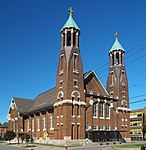Frogtown, Saint Paul
Asian-American culture in Minneapolis–Saint PaulHmong-American culture in Minneapolis–Saint PaulNeighborhoods in Saint Paul, MinnesotaPopulated places established in the 19th centuryVietnamese-American history

Frogtown is a neighborhood in Saint Paul in the U.S. state of Minnesota. Built around University Avenue, the Thomas-Dale neighborhood is colloquially known as Frogtown (German: Froschberg, meaning "Frogmountain"). Historically, Frogtown was a subsection of the current Thomas-Dale neighborhood. It is bordered by University Avenue on the south, the Burlington Northern Railroad tracks to the north, Lexington Parkway on the west and Rice Street on the east.
Excerpt from the Wikipedia article Frogtown, Saint Paul (License: CC BY-SA 3.0, Authors, Images).Frogtown, Saint Paul
Dale Street, Saint Paul Frogtown
Geographical coordinates (GPS) Address Nearby Places Show on map
Geographical coordinates (GPS)
| Latitude | Longitude |
|---|---|
| N 44.962777777778 ° | E -93.126111111111 ° |
Address
Minnehaha Av
Dale Street
55103 Saint Paul, Frogtown
Minnesota, United States
Open on Google Maps







